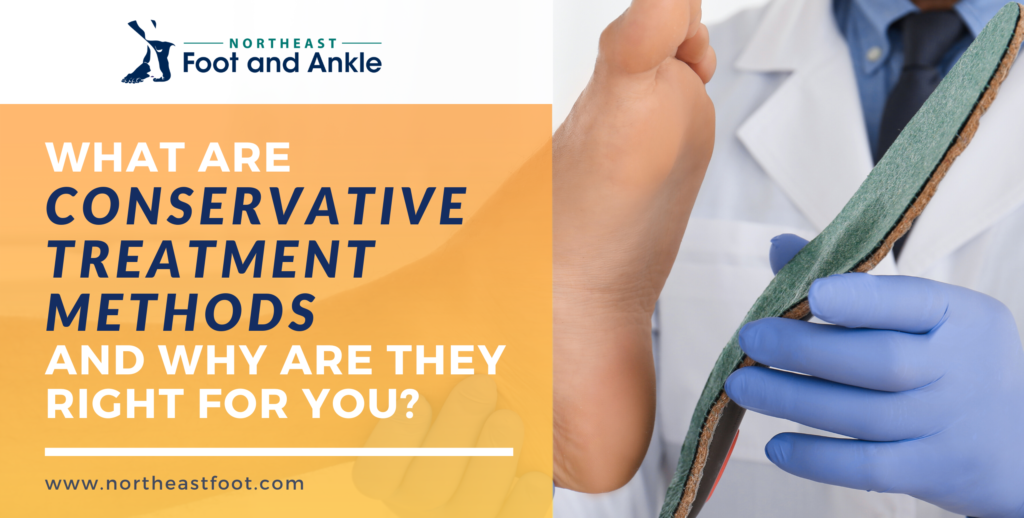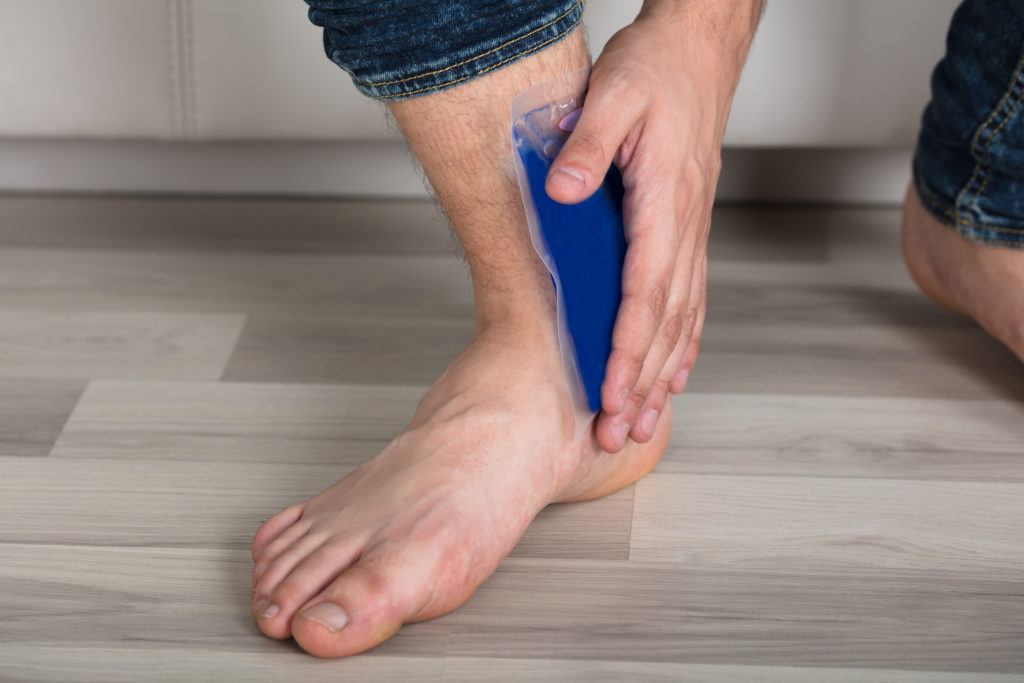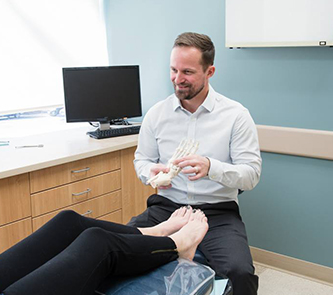What Are Conservative Treatment Methods and Why Are They Right for You?
Have you thanked your feet today?
Given how much they do for you on a regular basis, you probably should. After all, these valuable appendages allow you to move around, participate in physical activities, stand upright, and even drive your car.
Clearly, some appreciation is in order.
Of course, when your feet cause pain, difficulty, and/or frustration, it’s hard to have warm feelings toward them, right?
Unfortunately, due to the fact feet are both intricately structured and used for many types of activities, foot pain is a common problem – one that afflicts many people.
The good news is that many treatment options can help you find relief from foot pain. And we can say this definitively because our team does exactly that for people just like you every day.
When we treat foot and ankle problems, there are two general approaches we can take: conservative and surgical.
Conservative options tend to be the preferred path—for both you and us—so let’s look at what this entails and how we can help you get rid of pain in your feet.
Alright, what do we mean by conservative treatment?
This is rather straightforward and easy to understand:
Conservative foot care is the alternative to surgery.
If we do not have to perform an invasive technique to help improve an existing condition, the treatment is conservative.
Examples of conservative care and therapies include:
- Custom Orthotics
- Physical Therapy (PT)
- Hot/Cold Therapy
- Rest
- Medication
- Laser Therapy
- Extracorporeal Pulse Activation Technology (EPAT)
This list isn’t exhaustive, so just remember that when our treatment plans helps you avoid surgery, it’s conservative.
Why would we recommend a conservative treatment plan for your foot pain?
Obviously, being able to avoid surgery is a major benefit. Sure, our team is highly skilled and experienced in performing foot and ankle surgeries – but we prefer to reserve this as a last resort for cases that are severe and/or unresponsive to noninvasive therapies.
Beyond taking surgical intervention out of the picture, here are some other benefits for treating foot and ankle injuries with conservative methods:
- There are many options. As you can see in the previous list, our team can use a variety of potential treatments and techniques. This affords us a certain degree of flexibility in creating a custom plan for you.
- Conservative options can be used together. When your doctor creates a plan that incorporates a couple different therapies, they can work in conjunction to achieve multiple objectives. For example, we may be able to alleviate pain, reduce swelling, and promote enhanced healing all at the same time.
- Faster recovery and less downtime. Recovering from a foot or ankle surgery takes time as your body mends not only injured tissues, but also ones cut and stitched during the procedure itself. Plus, some of our advanced treatments can accelerate healing processes and further reduce how much time it takes to recover.
Speaking of advanced treatments and therapies…
What kinds of treatments are considered “advanced”?
We can take the category of conservative treatment and break into two general subsections: traditional and advanced.
In the case of traditional foot care, we’re talking about tried-and-true methodologies that, in some cases, have literally existed for ages. This category includes things like rest, ice, medication, compression, and physical therapy.
Those respective forms of treatment all have their benefits and we still use them to this day (because they’ve been consistently proven over time) – but technological advances give us additional options.
So, when we mention an advanced therapy, we’re talking about state-of-the-art technologies used to improve the care we can provide to you.
At Northeast Foot and Ankle, a couple of advanced treatments we proudly offer to relieve your foot pain and enhance healing are laser treatment and EPAT.
Our practice has an MLS® (Multiwave Locked System) laser that delivers concentrated light energy to injured soft tissue. Upon reaching the injury site, that energy stimulates natural growth and regeneration properties in cells.
EPAT is similar – with the key distinction being that the source of energy in this case isn’t from a laser, but rather specifically calibrated soundwaves. (For that reason, this is also known as shockwave therapy.)
With both treatments, we have patients who report having less pain and resuming normal activities more quickly than they otherwise would.
We have more information for you about our advanced options here.

Can physical therapy really help foot conditions?
A conservative option that can be great for both addressing a current problem and preventing one from either recurring or developing in the first place is physical therapy.
As you probably know, physical therapy (PT) consists of stretches and exercises intended to rehabilitate injuries and strengthen supporting tissues. A solid PT plan will also improve flexibility and range of motion in appropriate joints.
With that being the case, what exercises can help with foot pain and injury?
Well, like we’ve noted earlier, it really depends on your specific case.
Keeping that in mind, here are some activities that can be quite beneficial for foot health and recovery:
- Walking
- Swimming
- Cycling
- Yoga
Those forms of exercise are all rather unique in their respective ways, but they also have something in common – they are low-impact.
Low-impact exercises are ones that do not place a lot of stress and force on the lower limbs. That means you won’t usually need to do a lot running or jumping. Examples of high-impact activities include things like playing basketball and training for a marathon.
That’s not to say you shouldn’t participate in those kinds of activities if you enjoy doing so!
Rather, we’re just saying that you need to be more strategic when determining how much and often you do them.
On a related note:
While we love helping our patients find relief from foot pain, we know you’d probably prefer not to be hurt in the first place. Because of that, we’ve compiled nine expert tips to help you avoid heel pain into a complimentary guide for you.
If you’re interested, you can claim your free copy on this page!
What kinds of conditions can potentially benefit from conservative care?
If you have something like a compound fracture or need a hammertoe straightened, then surgery is almost certainly going to be the recommended option.
More often, our team can create a nonsurgical plan that at least has the potential to effectively resolve the problem – with surgery only as a last resort if all other options fail.
Foot and ankle problems which are frequently treated effectively without surgery include plantar fasciitis, Achilles tendinitis, turf toe, flat feet and ankle sprains.
Want to learn more about common foot conditions? Other site visitors find this page to be helpful.
Out of the various problems that can arise in our feet and ankles, the most frequently seen by podiatrists everywhere is heel pain.
That makes sense. By all accounts, it’s the leading type of foot pain.
So, if you are one of the millions who are afflicted, how do you get rid of the pain in your heel?
Given the subject of this blog post, it’s probably not terribly surprising to hear that conservative treatment options are remarkably effective at addressing this common problem. At the same time, you shouldn’t wait too long to go see a doctor for heel pain.
If you do, you run the risk of the problem becoming more severe over time. But, more immediately, you’re in pain and we have treatment options that can help!
And if you wonder how long it take for heel pain to go away, the answer will depend on various factors relating to your case. This is something you and your doctor will discuss at your appointment.

Why is Northeast Foot and Ankle a smart choice?
As you can see, when it comes to relieving foot pain, there’s not as much to worry about as you might have thought. In fact, the only major concern is not doing anything!
Remember, when you let the root causes of heel pain go untreated, they aren’t being addressed and, at best, won’t go away.
At the same time, you also risk having the problem responsible for your foot pain continue to develop and become more serious over time.
Instead of allowing that to happen, you might want to join fellow community members who make Northeast Foot and Ankle their first choice for conservative (and surgical) podiatric care.
If you do—or even if you just have questions or would like information about our practice—please feel free to give us a call at (603) 431-6070 and our team will be happy to help!
Pay Your Bill
Make a payment online through our payment portal or Care Credit!
Portsmouth Office
14 Manchester Square, Suite 250
Portsmouth, NH 03801
Nashua Office
17 Riverside Street, Suite 205
Nashua, NH 03062
Website Hosted by SC Digital



